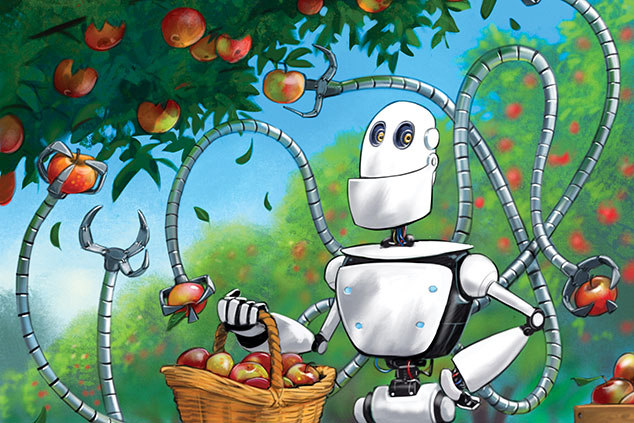Agri-tech: harvesting profits from the future of the food industry
The agricultural sector has long survived by throwing more pesticides, machines and land at every problem. That won’t work any more. Merryn Somerset Webb explores the agri-tech revolution.


"I have two boys, ten and 13, and they won't have enough food to eat in a few years' time." So said a climate-change protestor to Richard Madeley on Good Morning Britain. Madeley looked mildly bemused. Probably for good reason. Right now, the planet has no shortage of food. According to the United Nations Food and Agriculture Organisation, around 10% of the world's population is malnourished in some way (though this figure has halved in the last 20 years). But that malnutrition, sadly, reflects more of a distribution problem than a production problem.
An estimate from the Boston Consulting Group (BCG) in 2018 suggested that around one third of the food produced globally ends up wasted: 1.6 billion tonnes with a value of around $1.6trn. That's partly a function of consumer incompetence (we buy too much and don't understand the subjective nature of sell-by dates). But it's also a result of the failure of food companies to match up supply and demand properly, while lousy infrastructure and distribution systems are the main problem in many parts of the world. Still, the idea that with this surplus knocking around children in the UK will be hungry in a few years' time seems a bit nuts.
But will that change a few decades out? The global population is forecast to hit 9.7 billion by 2050 (it's around 7.5 billion now), so there might be an extra two billion mouths to feed in a mere 30 years' time. Capture all the waste mentioned above, chuck in a few small productivity increases, and that doesn't look like a problem. Don't capture it (BCG assumes that waste will rise as the global population gets richer and less careful about calories), fail to boost productivity, and it might be.
MoneyWeek
Subscribe to MoneyWeek today and get your first six magazine issues absolutely FREE

Sign up to Money Morning
Don't miss the latest investment and personal finances news, market analysis, plus money-saving tips with our free twice-daily newsletter
Don't miss the latest investment and personal finances news, market analysis, plus money-saving tips with our free twice-daily newsletter
Climate change is crucial
However, there's another element in here: climate change. We need to think about changing how we grow and use food in the medium term because the global population is growing, but also because the agricultural sector as a whole is a significant contributor to global warming. Agricultural activities account for around 14% of total greenhouse gas (GHG) emissions, notes a recent report from Barclays Investment Bank (as well as nearly 100% of human nutritional intake). In the case of arable farming the majority of emissions are due to the release of nitrous oxide associated with the intense use of fertiliser. In livestock farming they stem from the methane produced by ruminant animals, especially cows look up enteric fermentation if you want to know how this works
"One third of global food production, 1.6 billion tonnes worth $1.6trn, is wasted"
Deforestation to create land for more animals and grow crops for grain-fed ruminants adds nastily to the problem; some estimates take the impact of agriculture up to 25%-30% of GHG emissions. According to Global Forest Watch, the world lost 15.8 million hectares of forest in 2017 alone. There are arguments to be had about the size of this problem relative to emissions from other parts of the economy. And there are definitely arguments to be had about how the various different types of farming should be treated.
Are cows the chief culprits?
Take cows, often seen as the villains of the piece. It's probably fair to say that keeping cows locked up in sheds or on grass-free feedlots and feeding them grain grown elsewhere is very bad for the environment. But there is a good argument for increasing the number of ruminants we feed on natural pasture land using a technique known as adaptive multi-paddock (AMP) grazing. This attempts to replicate the way herds of animals would naturally have moved around grassland.
This increases biodiversity of plants and wildlife; is good for the health of (and resulting quality of food from) the animals; hugely increases the fertility of the land; and can result in large amounts of carbon being held in the soil. At the same time, the fewer cereals you grow to feed cattle the better: too much unsuitable land in South America is used to grow soya. Would-be vegans should also remember that growing the three crops that make up 60% of calories eaten globally (rice, wheat and maize) is not just horrible for biodiversity and soil health, but also a hugely intensive fossil-fuel and pesticide-heavy business, and one that many now think hampers the sequence of natural sequestration of carbon in soil as well as destroying the topsoil itself. Soil depth in Iowa, one of the world's most industrially farmed areas, fell from 14 inches in 1850 to a mere 4.8 inches in 2017.
Productivity growth is dwindling
That makes a huge difference to our ability to squeeze food from the land. It is also one reason, as Jeremy Grantham of asset management group GMO recently noted, why growth in many crop yields is "moving towards zero" despite heavy use of fertilisers. We use five times as much fertiliser as we did in the 1960s, but the average annual-yield growth from corn, wheat, soy and rice in the US actually slipped to 1% between 1990 and 2010, compared with 1.5% between 1970 and 1990. GMO forecasts a further fall of 0.25% in the US by 2030. It's much the same story in Germany, the UK and France. Global grain productivity doesn't look too good either: it is rising at around 1.2% (about the same speed at which the global population is growing). For context note that in the green revolution of the 1950s and 1960s productivity was rising at around 3.5% a year.Grantham makes one more vital point. We lose "as much of our crop to weeds, bugs, and pathogens today, as a percentage, as we did in 1945 before we declared chemical war on these organisms... If we pull back from the chemicals now, the bugs and weeds, which have turned into superbugs and superweeds, will eat our lunch, breakfast, and dinner. Had we never done it, we would be losing approximately the same amount as we are now, but saving impressive amounts of money approximately as much as for feed or fertiliser". We are also losing around 0.5% of our arable land every year to climate change (more violent downpours are mostly to blame here). Urbanisation and growing water scarcity are further reasons to worry, says Grantham, that "in 80 years, current agriculture will be simply infeasible".
Low-tech solutions
So agriculture is in trouble. Part of the solution is very low-tech. The AMP systems suggested above harks back to the past, and the idea that pasture-fed animals bred on permanent pasture are part of the solution, not the problem, is beginning to gain ground. There is also growing appreciation of the worth of integrated livestock farming (where vegetable waste is recycled to animals and manure recycled into compost to the huge benefit of the soil); of no-till or low-till arable farming (to help reduce erosion); and of the importance of diverse diets for people. Huge monoculture farms are no longer considered the default option.
"We might soon find ourselves eating a lot of high-protein algae"
Questions are also being asked about modern food processing and the big food brands associated with it. It is an energy-intensive business and we increasingly understand how bad it is for human health (the sharp rises in cancer, heart disease and diabetes can be partly ascribed to the industry). We might, we realise, be better moving back to eating unprocessed whole foods (vegans planning to live on artificial meat, take note) and a much larger variety of them to boot.
At the same time there is a regulatory response on the way. California has already passed "draconian rules demanding a 40% cut in greenhouse emissions from its 1.7 million herd of cows by 2030", says Ambrose Evans-Pritchard in The Daily Telegraph. And Canada has recently launched a carbon-offset scheme for farmers.
High-tech solutions
Then there are high-tech solutions. Grantham notes that environmentalists "have no idea how rapidly technology is accelerating" in response to agriculture's rising-demand and static-production dynamic. In the arable sector new types of intensive data management methods can tell farmers square metre by square metre exactly where the nutrients are lacking and where more water is needed, for example. Such "precision farming" could cut fertiliser and pesticide volumes, increase yields (experiments suggest by 3%-12%) and improve the long-term health of our soil.
There is also interesting work being done on the vertical stacking of agriculture in artificial environments. For a hint of what can be achieved, look up hydroponics start-up LettUsGrow and the underground salad farm 33 metres below London, an example of a "controlled environment technology" (Growing-underground.com). We might also soon find ourselves eating a lot of high-protein algae, production of which is both fast and environmentally friendly. In the longer term there is gene editing, a field that might develop faster than genetic modification has been able to because it involves editing the genes of a plant, a less controversial undertaking than adding new DNA, which occurs in genetic modification. The EU is still uncertain, but in the US it seems that gene-edited crops will not fall under the same regulatory regime as genetically modified organisms (GMOs). That would pave the way towards what the FT calls a "transformation of agricultural production". Crops could be edited to make them resistant to disease, for instance.
There is also fascinating work going on at California's Salk Institute to develop new varieties of plants that can hold much more carbon in their roots than most. Then there are naturally occurring microbes that can improve plant yields or protect them against pests. Boston-based Indigo Agriculture focuses on "survivor" plants those able to grow under challenging environmental conditions and then tries to match plants with a perfect microbiome. There is brilliant work under way in the livestock sector too. A Dutch firm is attempting to produce a "Clean Cow" feed that will make cows belch up to 25% less, while Swiss agri-tech firm Agolin Ruminant is developing a feed that includes essential oils such as coriander and cloves in an attempt to do the same.
Apps for agriculture
Nonetheless, the fastest route to improving productivity in the sector is likely to be digital. Robeco Asset Management says we can now process so much information so fast that it is "possible to collect, classify and analyse vast amounts of information to detect patterns and solutions previously disguised in chaos". There are weather apps that suggest the best time to plant crops; robot fruit-pickers that use sensors to cut waste; apps to measure crop development; manure-management apps (notably the Farm Crap App), machines that can electronically "zap" weeds from the root up; and drones that can survey land and track livestock. Firms are working on devices with face-scanning technology to locate dairy cows that look unwell and special wearables (think Fitbits for cows) to detect problems.
"A Dutch firm is working on a feed that will make cows belch 25% less"
In 2017 the amount of funding raised globally by agri-tech start-ups reached more than $10bn, a 29% increase year on year. Some of these are going to become multi-billion dollar companies, Daniel Epstein the founder of Unreasonable Group, which invests in growth-stage food businesses, told the FT. In other good news the UK, which led the last agricultural revolution in the 1870s, and boasts some of the most established agricultural research centres in the world, is in good agri-tech shape.
Brexit should give us the chance to transform our agriculture, horticulture and forestry and the UK government is strongly backing agri-tech which is already worth more than £14bn and employs in excess of 500,000 people with four Agricultural Innovation Centres. In 2017 the UK was the third-most active country for agrifood-tech start-up funding, raising more than $500m across 69 deals, according to AgFunder data. The agricultural industry has long survived by chucking pesticides, herbicides, bigger machines and more land at every problem. That isn't working any more so the future of food is going to be a very disruptive one. See the box below for some of the best ways in.
The stocks and funds to buy now
The agri-tech business is still dominated by start-ups and small companies, but there are some listed firms, both big and small, worth looking at. Two suggested by analysts at Amundi are livestock genetics company Genus (LSE: GNS) and Eco Animal Health Group (Aim: EAH), a livestock pharmaceutical group that produces an antibiotic to treat a range of specific enteric and respiratory diseases in pigs and poultry.
Both could see short-term pain from the African swine fever outbreak, but over the long term they will benefit from the reduction in the number of "backyard pigs" in China and the shift towards China's huge levels of pork consumption being catered for by professional pork producers. For those interested in wearables for cows there is Avon Rubber (LSE: AVON), which makes military respiratory protection systems and milking equipment for cows, as well as devices that monitor an animal's general health, including, importantly, if it is ready for insemination.
Also of possible interest is Anpario (Aim: ANP), which produces animal-feed additives with a particular focus on gut health. Even riskier might be the currently loss-making Benchmark Holdings (Aim: BMK), which specialises in the genetics and feeding of aquaculture livestock. Outside the UK, Barclays suggests the Dutch company making the Clean Cow Feed, DSM (Amsterdam: DSM). The product will be a "genuine blockbuster" for the firm as farmers try to reduce the environmental footprint of their livestock.
Among larger firms, tractor company John Deere (NYSE: DE) is worth a look. It has been using driverless vehicles for a while; recently bought out a robotics start-up; and has a new artificial intelligence system called "See & Spray". It uses facial recognition technology to scan crops and spray pesticides and herbicides only when it sees bugs or weeds. This, it reckons, can reduce pesticide use by 90% with no negative effects on yields.
In the digital agriculture area, Maxx Chatsko of Fool.com suggests fertiliser company Nutrien (NYSE: NTR), which is making the kind of investments into digital agriculture platforms that suggest that it could soon grow into "a much more resilient business". You could also get exposure to both of these firms with the iShares Agribusiness UCITS exchange-traded fund (LSE: SPAG). John Deere and Nutrien are the top two holdings and jointly comprise a fifth of the portfolio.
Sarasin has a Food and Agricultural Opportunities Fund whose biggest holding is John Deere. The RobecoSAM Sustainable Food Equities Fund is worth researching further. There are also two private agri-tech funds , the Singapore-based Asia AgriTech Fund and Israel's Natura Fund, which some might be able to get access to. Otherwise, Jeremy Grantham is clearly on top of the subject so you might look to GMOs Climate Change Fund, which is around 23% invested in agriculture. Those who don't mind diluted exposure to agri-tech might try Baillie Gifford's US Growth Trust (LSE: USA) (many readers will hold this already), which I mention purely because in its unlisted portfolio it holds Indigo Agriculture, the microbiome firm I mention above.
Get the latest financial news, insights and expert analysis from our award-winning MoneyWeek team, to help you understand what really matters when it comes to your finances.
Merryn Somerset Webb started her career in Tokyo at public broadcaster NHK before becoming a Japanese equity broker at what was then Warburgs. She went on to work at SBC and UBS without moving from her desk in Kamiyacho (it was the age of mergers).
After five years in Japan she returned to work in the UK at Paribas. This soon became BNP Paribas. Again, no desk move was required. On leaving the City, Merryn helped The Week magazine with its City pages before becoming the launch editor of MoneyWeek in 2000 and taking on columns first in the Sunday Times and then in 2009 in the Financial Times
Twenty years on, MoneyWeek is the best-selling financial magazine in the UK. Merryn was its Editor in Chief until 2022. She is now a senior columnist at Bloomberg and host of the Merryn Talks Money podcast - but still writes for Moneyweek monthly.
Merryn is also is a non executive director of two investment trusts – BlackRock Throgmorton, and the Murray Income Investment Trust.
-
 Nationwide fined £44 million over “inadequate” anti-money laundering systems
Nationwide fined £44 million over “inadequate” anti-money laundering systemsFailings in Nationwide’s financial crime processes between October 2016 to July 2021 meant one criminal was able to deposit £26 million from fraudulent Covid furlough payments in just eight days.
-
 MoneyWeek news quiz: How much will a 2026 FIFA World Cup final ticket cost?
MoneyWeek news quiz: How much will a 2026 FIFA World Cup final ticket cost?Quiz The 2026 World Cup, Netflix, and the cost of care all made headlines this week. How closely were you following this week’s top stories?
-
 Invest in space: the final frontier for investors
Invest in space: the final frontier for investorsCover Story Matthew Partridge takes a look at how to invest in space, and explores the top stocks to buy to build exposure to this rapidly expanding sector.
-
 Invest in Brazil as the country gets set for growth
Invest in Brazil as the country gets set for growthCover Story It’s time to invest in Brazil as the economic powerhouse looks set to profit from the two key trends of the next 20 years: the global energy transition and population growth, says James McKeigue.
-
 5 of the world’s best stocks
5 of the world’s best stocksCover Story Here are five of the world’s best stocks according to Rupert Hargreaves. He believes all of these businesses have unique advantages that will help them grow.
-
 The best British tech stocks from a thriving sector
The best British tech stocks from a thriving sectorCover Story Move over, Silicon Valley. Over the past two decades the UK has become one of the main global hubs for tech start-ups. Matthew Partridge explains why, and highlights the most promising investments.
-
 Could gold be the basis for a new global currency?
Could gold be the basis for a new global currency?Cover Story Gold has always been the most reliable form of money. Now collaboration between China and Russia could lead to a new gold-backed means of exchange – giving prices a big boost, says Dominic Frisby
-
 How to invest in videogames – a Great British success story
How to invest in videogames – a Great British success storyCover Story The pandemic gave the videogame sector a big boost, and that strong growth will endure. Bruce Packard provides an overview of the global outlook and assesses the four key UK-listed gaming firms.
-
 How to invest in smart factories as the “fourth industrial revolution” arrives
How to invest in smart factories as the “fourth industrial revolution” arrivesCover Story Exciting new technologies and trends are coming together to change the face of manufacturing. Matthew Partridge looks at the companies that will drive the fourth industrial revolution.
-
 Why now is a good time to buy diamond miners
Why now is a good time to buy diamond minersCover Story Demand for the gems is set to outstrip supply, making it a good time to buy miners, says David J. Stevenson.
